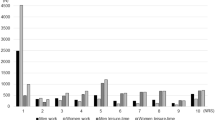Abstract
The common cold persists as a major economic and public health problem worldwide. Despite its long-established ubiquity, little is yet certain about the determinants of indoor environment in spreading of the infection, and even less about the role of indoor air quality as a mediator. The effect of sharing an office with one or more colleagues on the risk of the common cold was studied in a modern, mechanically ventilated, 8 story office building in central Helsinki. Data on respiratory infections and the relevant personal and environmental determinants were collected in a self-administered questionnaire (response rate 71.0%). The study population, one person from each office on floors 3 to 8, consisted of 893 workers, 493 males (49.2%) and 454 females (50.8%). In logistic regression analysis the adjusted odds ratio (OR) for more than two episodes of common cold during the past 12 months in subjects with one or more office colleagues vs those working alone was 1.35 (95% CI 1.00–1.82). Among all workers higher risk also emerged for those with young children (OR 1.46, 1.05–2.04) or a history of hay fever (OR 2.07, 1.47–2.92). Females (OR 1.25, 0.95–1.66) and all under 40 years of age (OR 1.15, 0.86–1.55) had non-significantly increased risk, while smokers did not differ essentially from non-smokers (OR 1.05, 0.76–1.42). The results suggest that sharing office space increases the risk of the common cold, although the primary mode of transmission — airborne, direct or indirect contact-remains controversial.
Similar content being viewed by others
References
Couch RB. The common cold: Control? J Infect Dis 1984; 150: 167–173.
Couch RB, Douglas RD, Lindgren KM, Gerone PJ, Knight V. Airborne transmission of respiratory infection with coxsackie virus type 21. Am J Epidemiol 1970; 9: 78–86.
Dicke EC, Jennings LC, Mink KA, Wartgow CD, Inhorn SL. Aerosol transmission of rhinovirus colds. J Infect Dis 1987; 156: 442–448.
Cate TR. Self-control of the common cold? Ann Intern Med 1978; 88: 569–570.
Lidwell OM, Sommerville T. Observations on the incidence and distribution of the common cold in a rural community during 1948 and 1949. J Hyg (Camb) 1951; 49: 365–381.
Dingle JD, Badger GF, Jordan WS Jr. Illness in the home: A study of 25,000 illnesses in a group of Cleveland families. Cleveland, OH: Western Reserve University, 1964.
Strangert K. Respiratory illness in preschool children with different forms of day care. Pediatrics 1976; 57: 191–196.
Bell DM, Gleiber DW, Mercer AA, et al. Illness associated with child day care: A study of incidence and cost. Am J Public Health 1989; 79: 479–484.
Fleming DW, Cochi SL, Hightower AW, Broome CV. Childhood upper respiratory tract infections: To what degree is incidence affected by day-care attendance/ Pediatrics 1987; 79: 55–60.
Louhiala P, Jaakkola N, Ruotsalainen R, Jaakkola JJK. Form of day-care and respiratory infections: A public health perspective. Am J Public Health (in press).
Dick EC, Blumer CR, Evans AS. Epidemiology of infections with rhinovirus types 43 and 55 in a group of University of Wisconsin student families. Am J Epidemiol 1967; 86: 386–400.
Author information
Authors and Affiliations
Rights and permissions
About this article
Cite this article
Jaakkola, J.J.K., Heinonen, O.P. Shared office space and the risk of the common cold. Eur J Epidemiol 11, 213–216 (1995). https://doi.org/10.1007/BF01719490
Accepted:
Issue Date:
DOI: https://doi.org/10.1007/BF01719490



